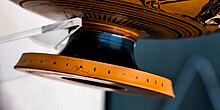Dionysus Cup

The Dionysus Cup is the modern name for one of the best known works of ancient
Description

The cup is 13.6 cm high and has a diameter of 30.5 cm. It is complete and composed of only a few large sherds. The inside image, the
Context

Two meanings have been suggested for the interior image. Most common is the suggestion that is a reference to the seventh
Innovation
The cup shows numerous technical innovations. As a potter, Exekias took older forms and reshaped them into a completely new one. This form, the so-called Cup type A with a thicker foot, a ring around the stem, and a deep, broad bowl, would quickly become the dominant form. The "eye-cup" motif was originally introduced by Exekias, possibly with this piece. Later on the nose in between the eyes grew rarer. The decoration around the handles was similarly new, but unlike the other innovations it did not catch on. Neither did the tondo nearly completely filling the inside of the cup, which was notably imitated later on by the Penthesilea Painter, but is otherwise rather uncommon. Hitherto it had been common in general for the interior of a cup to be decorated with a small tondo depicting a gorgoneion. Also new, but only employed experimentally for a few years and then only rarely was the technique of Intentional Red, in which the background was made an intense, dark red clay. For this too, the cup is the earliest example. Inside of the cup, the decoration has no horizon line or specific orientation other than the ship and the grapes.[4]
History

It is clear that Exekias was the potter, since he signed the foot with an inscription reading EΞΣΕΚΙΑΣ ΕΠΟΕΣΕ ("Exsekias made this"). The attribution of the painting to him derives from stylistic comparisons. Although the internal chronology of Exekias' works is still not fully understood, the cup is generally placed among his later works. The exact date varies between 540 and 530 BC.
The cup was found during Lucien Bonaparte's excavations at Vulci and acquired for Ludwig I of Bavaria in 1841.
References
- ^ Inventory number 8729 (formerly 2044); evaluation of worth by John Boardman, Schwarzfigurige Vasen aus Athen. Mainz 1977, p. 64 and Thomas Mannack: Griechische Vasenmalerei. Stuttgart 2002, p. 121
- ^ Description follows Matthias Steinhart, "Exekias" in Künstlerlexikon der Antike. Vol. 1. München, Leipzig 2001, pp. 249–252.
- ^ Context after Matthias Steinhart, "Exekias" in Künstlerlexikon der Antike. Vol. 1. München, Leipzig 2001, pp. 249–252.
- ^ Artstor. "Artstor". library.artstor.org. Retrieved 2017-10-01.
Bibliography
- John Beazley. Attic Black-figure Vase-painters. Clarendon Press, Oxford 1956, p. 146 No. 21.
- ISBN 3-8053-0233-9, p. 64.
- Matthias Steinhart. "Exekias" in Künstlerlexikon der Antike. Vol. 1. Saur, München, Leipzig 2001, pp. 249–252.
- ISBN 3-8062-1743-2, p. 121.
- ISBN 3-406-51960-1, pp. 14–19 tbl. 1–4.
External links
- Attic Black-figure Eye cup of Exekias (München, Staatliche Antikensammlung) in the archaeological database Arachne
